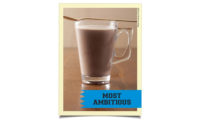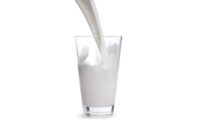We dusted off the jukebox to play the songs that best represent dairy foods and beverages. Our annual State of the Dairy Industry report examines the prospects for all dairy categories. For the fluid milk category, we selected “Will You Love Me Tomorrow?” which characterizes the not-so-happy outlook for white milk.
If beef is what’s for dinner, then milk is what’s for breakfast. At least that’s the approach the milk industry is taking, led by its marketing arm, the Milk Processor Education Program, better known as MilkPEP. The Washington, D.C.-based trade group funded by milk processors has long talked about “defending breakfast” and making sure that a gallon of milk was on the table in the morning.
But times have changed. Americans eat breakfast on the go or skip the meal entirely. As white milk sales have declined, so have cereal sales.
To reclaim its traditional seat at the breakfast table, the dairy industry has teamed up with cereal maker Quaker Oats. In a campaign that launched in September, Quaker encourages consumers to make oatmeal with 8 ounces of low-fat milk instead of water and to serve it with a glass of milk. With 16 grams of protein from two cups of milk and 5 grams of protein from the oats, the meal contains 21 grams. That easily meets a child’s daily needs, according to the federal Centers for Disease Control and Prevention. (The daily recommendation for adult women and men is 46 to 56 grams, respectively.)
“The goal of Quaker’s partnership with America’s milk companies and dairy farmer families reinforces the value of high-quality protein and whole grains to start the day right. By coming together, these two breakfast staples create a breakfast powerhouse,” said Jody Menaker, director of communications for Quaker Foods North America.
In other words, oatmeal is more “nutrient dense” when made with milk, not water. The potential impact on the dairy industry is huge. Barbara O’Brien, the executive vice president of the Innovation Center for U.S. Dairy, said that converting 1% of oatmeal breakfasts from water to milk represents an increase of 30 million pounds of milk. That’s a boon for dairy farmers who fund Dairy Management Inc. and its units (like the Innovation Center) through the dairy checkoff.
The Quaker Oats man (known as Larry) appears in ads and on 12 million oatmeal canisters with MilkPEP’s famed milk mustache. This is the first time Quaker has transformed it iconic canister. The “Make It With Milk” message also is featured on more than 8 million gallons of milk. In-store point-of-sale materials promote the partnership as well.
Aside from the MilkPEP partnership, Quaker also promotes milk in its recipes for smoothies. A Mango Ginger Smoothie recipe, for example, calls for a half-cup of milk, rolled oats, fruits and other ingredients.
It is no surprise that Quaker is becoming more involved with dairy foods. A joint venture with European yogurt maker Theo Muller Group, known as Muller Quaker Dairy, built a dairy in Batavia, N.Y., where it makes conventional yogurt, Greek yogurt and a fruit mousse yogurt (See Dairy Foods, June 2014.) Quaker is a division of snack food and soft drinks giant PepsiCo, which owns the largest dairy in Russia.
“Aside from Muller Quaker Dairy, Quaker does not have any specific milk-based products at this time,” Menaker said.
Quaker is not the only food company looking at milk. In June 2013 Kellogg’s introduced shelf-stable bottled breakfast shakes and a shake mix to win a share of the grab-and-go market. The milk chocolate, strawberry and vanilla flavors contain 10 grams of protein and 5 grams of fiber per bottle. The milk shakes are sold in 10-ounce bottles in packages of four for a suggested retail price of $6.49. The mix is prepared at home with skim milk.
Adding value to milk
“Milk and milk drinks are targeting the sports nutrition and energy drinks market with ready-to-drink, nutritionally enhanced products. These products are targeted both at the sportsman and the generally active population with health-conscious lifestyles,” said trendwatcher Lu Ann Williams, the director of innovation for Innova Market Insights, The Netherlands.
Dairy processors also have heeded the protein message and have developed value-added milk beverages. While one cup of milk contains 8 grams of protein naturally, processors’ new protein-fortified beverages deliver 12 grams or more. Dean Foods, Lucerne (Safeway), Borden, Organic Valley and Fairlife are among those with high-protein beverages made with milk. Processors boost protein levels by adding powders or through filtration to concentrate the nutrient. (Listen to Fairlife CEO Steve Jones speaking at Dairy Foods’ webinar on value-added milks on dairyfoods.com.)
While whole milk sales have been in decline for decades, sales of flavored milks have performed better. As reported by the USDA, sales of “other flavored milk” were greater in 2013 than 10 years ago (3.8 billion pounds compared to 3.4 billion in 2004) and hit a peak of 4.1 billion pounds in 2010. Flavored whole milk sales, a much smaller category, have declined every year since 2003 (except for a bounce in 2012), totaling 573 million pounds in 2013.
The traditional flavors – chocolate, strawberry and vanilla – have been supplanted by the likes of jelly bean, vanilla cupcake and pumpkin. Milk processors are finding success with these nontraditional flavors as part of a limited-time-only program. For example, Hiland Dairy, a unit of Prairie Farms, has been successful with seasonal flavored milk programs, such as Jelly Bean in the spring and Pumpkin in the autumn. Sold in quarts, the products represent additional business for the dairy, said Kathy Broniecki of Envoy Inc., Omaha, Neb., who heads Hiland’s marketing strategy. These sweeter milks are consumed as desserts or treats, she said.
Seasonal offerings are old hat for ice cream processors, who also develop flavors with candy and cookie brands. Late this summer, Nestlé followed that strategy by releasing two Nesquik beverages based on Girl Scout Cookie flavors— Thin Mints and Caramel Coconut — as part of a licensing relationship with Girl Scouts of the USA. The limited-edition product retails for $1.99.
Milk processors are also developing value-added dairy-based coffee drinks. In May, Pennsylvania-based dairy processor Turkey Hill, a unit of Kroger, rolled out Ooo-La-Latte in 18.5-ounce single-serve and 57.6-ounce family sizes. The beverages are made with fresh milk and 100% brewed Colombian coffee. The flavors are vanilla and mocha.
Organic dairy farmer Kimball Brook Farm added to its Iced Cappuccino line with vanilla, caramel and mocha flavors at the beginning of the year. The beverages are sold in 8-ounce bottles. Green Mountain Organic Creamery, Hinesburg, Vt., processes the milk.
Chocolate milk for adults
Flavored milk faces tough sledding in public schools because some parents object to the calories and added sugar in the beverages. MilkPEP made a lot of headway with its campaign promoting chocolate milk as the “official” drink of Halloween. That promotion has gained traction with milk processors and their retail customers.
Now MilkPEP is marketing chocolate milk to adults, primarily those who participate in sports and other physical activities. It latched on to research showing that the ratio of protein to sugar in chocolate milk helps athletes recover quickly from a strenuous workout.
Originally known as refuel, the campaign is now known as Build It. MilkPEP is using public relations, advertising, events and partnerships to increase sales of chocolate milk. It has succeeded in having chocolate milk designated as the official refuel beverage of Ironman, Iron Girl, Lifetime Fitness, USA Hockey and the Rock ‘n’ Roll marathon series.
Originally focusing on hard-core physical fitness buffs like triathletes, the campaign now targets anyone who has unrolled a yoga mat or picked up a dumbbell. MilkPEP is seeking to influence the 67.3 million Americans who work out, from those who exercise daily (known as “self-motivators”) to “competitors” to “get in shape girls” (adult women who want to exercise more often but need motivation).
MilkPEP’s goals are to generate awareness and education about the benefits of drinking chocolate milk after a workout, drive consumption of chocolate milk and increase the number of athletes who include chocolate milk after working out.
The message that chocolate milk is an effective post-workout beverage has received “a huge amount of national mainstream media attention,” said Miranda Abney. OK magazine, Glamour and People.com are among the outlets reporting the recovery story.
Milk processors can leverage MilkPEP’s marketing efforts by providing milk at athletic events like half- marathons (“the point of sweat,” in Abney’s words), creating in-store display programs with grocers, couponing and using social media platforms like Twitter, Facebook and Instagram.
MilkPEP says Build It is working. Among adults who exercise at least twice a week, 41% are aware of the campaign, and 18% drank chocolate milk in the past day, according to MilkPEP. Olympic gold medal short-track skater Apolo Ohno has incorporated chocolate milk into his diet as he trains for the Iron Man triathlon (2.5 mile swim, 100 mile bike ride, 26.2 mile run) in Kona, Hawaii. Webisodes (videos posted on a website) follow Ono through his training.
Chocolate milk has even found its own partner in the cereal aisle. Wheaties, General Mills’ “breakfast of champions,” has tied itself with Tough Mudder challenges. Tough Mudder events have participants running 10 miles through a muddy obstacle course that might include ice, fire and electro-shocks. A special-edition package called Muddy Wheaties features chocolate milk and a Tough Mudder athlete. Consumers can interact with the package with the Blippar app.
When the National Collegiate Athlete Association this summer relaxed rules on meals and snacks for athletes, the market for flavored milk expanded. Athletic departments can now offer unlimited snacks, like chocolate milk, which are free to those on scholarships. Mark Farmer, who works for the Southeast United Dairy IndustryAssociation, Atlanta, said his group is placing refrigerated coolers in many ACC and SEC conference universities and working with nutrition directors to explain the post-workout benefits of chocolate milk. Foodservice distributors usually purchase the milk from local processors.
Who wants to be a milk processor?
While the decline in milk consumption has been well-documented, perhaps the lesser-known story is that the number of plants processing milk is half of what it was a generation ago. In 1988, the USDA counted 665 plants. By 2011, the number stood at 332. But those plants are much more productive. The average volume processed was 191 million pounds of milk in 2011, compared to 83.6 million in 1988.
Rising prices represent another challenge for milk processors to deal with. Milk prices have been rising steadily since the summer of 2009 when a gallon was $2.992, according to the Bureau of Labor Statistics. In April 2014, a gallon of milk peaked at $3.687 before falling back to $3.673 in August. Don’t expect milk to be any less expensive. World demand for milk is increasing.
To ensure success, dairy processors have to develop products that complement the commodity gallon jug of white milk, said Tom Gallagher, the chairman of Dairy Management Inc. Processing milk is not an “either-or” proposition, he said. Dairy processors need to balance their portfolios with commodity and value-added products.
For milk processors to succeed, they need to continue to develop value-added milks (like high-protein and novelty flavors), serve niche markets (like Tough Mudders) and exploit the potential in export markets. If they can do all that, then the answer is “yes” to the question asked by The Shirelles: “Will you love me tomorrow?”













